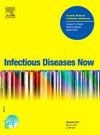Infectious foodborne disease outbreaks and sporadic cases in Saudi Arabia: A 2017–2023 trend analysis
IF 2.2
4区 医学
Q2 INFECTIOUS DISEASES
引用次数: 0
Abstract
Aim
The present study aims to precisely indicate the status of infectious foodborne disease in Saudi Arabia between 2017 and 2023.
Subject and methods
A trend analysis was conducted based on epidemiologic data in Saudi Arabia during 2017–2023. The data include reports from governmental and private health agencies regarding Saudi citizens and residents, whatever their ages, who were diagnosed with infectious foodborne disease. Outbreak and sporadic patients were evaluated. Saudi Arabian crude incidence rates per 100,000 inhabitants and foodborne pathogens were established.
Results
All in all, 42,079 infectious foodborne illnesses were reported in Saudi Arabia between 2017 and 2023; the crude incidence rate averaged 18.0 ± 5.7 per 100,000. In 2017–2023, there were 12,710 foodborne outbreaks with a mean incidence rate of 5.4 ± 2.2 per 100,000. Results also indicate 29,369 sporadic cases reported during 2017–2023, with a mean crude incidence rate of 12.6 ± 3.9 per 100,000. The most widely described pathogen was Entamoeba spp. (mean crude incidence rate of 6.3 per 100,000), followed by Salmonella spp. (5.6 per 100,000), Hepatitis A virus (0.5 per 100,000), and Shigella spp. (0.2 per 100,000).
Conclusion
This research presents trends regarding for confirmed infectious foodborne cases in Saudi regions from 2017 to 2023. Outbreak-related and sporadic cases have decreased in recent years. Given the high incidence of Entamoeba and Salmonella spp. in foodborne sporadic cases, health agencies are called upon to use diagnostic tools for frequently reported microbes in view of identifying and locating foodborne outbreaks.
沙特阿拉伯传染性食源性疾病暴发和散发病例:2017-2023年趋势分析
目的本研究旨在准确显示2017年至2023年沙特阿拉伯传染性食源性疾病的状况。研究对象和方法基于2017-2023年沙特阿拉伯流行病学数据进行趋势分析。这些数据包括来自政府和私人卫生机构的关于沙特公民和居民的报告,无论其年龄大小,都被诊断患有传染性食源性疾病。对暴发和散发患者进行了评估。确定了沙特阿拉伯每10万居民的粗发病率和食源性病原体。结果2017年至2023年,沙特阿拉伯共报告了42079例传染性食源性疾病;粗发病率平均为18.0±5.7 / 10万。2017-2023年,共发生12710起食源性疫情,平均发病率为5.4±2.2 / 10万。2017-2023年报告散发病例29369例,平均粗发病率为12.6±3.9 / 10万。最广泛描述的病原体是内阿米巴原虫(平均粗发病率为6.3 / 10万),其次是沙门氏菌(5.6 / 10万)、甲型肝炎病毒(0.5 / 10万)和志贺氏菌(0.2 / 10万)。结论本研究揭示了2017 - 2023年沙特地区食源性传染病确诊病例的趋势。近年来,与疫情有关的零星病例有所减少。鉴于内阿米巴原虫和沙门氏菌在食源性散发病例中的高发病率,呼吁卫生机构对经常报告的微生物使用诊断工具,以确定和定位食源性暴发。
本文章由计算机程序翻译,如有差异,请以英文原文为准。
求助全文
约1分钟内获得全文
求助全文
来源期刊

Infectious diseases now
Medicine-Infectious Diseases
CiteScore
7.10
自引率
2.90%
发文量
116
审稿时长
40 days
 求助内容:
求助内容: 应助结果提醒方式:
应助结果提醒方式:


